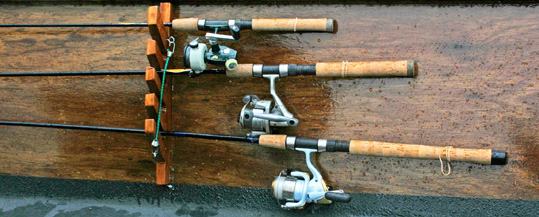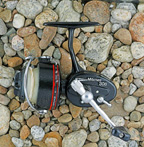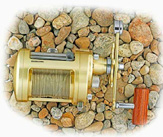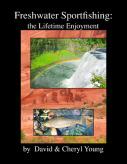Rods and Reels
For most of my fishing, I rely upon three spin rods: a 6 ½ foot light action, a 7 or 7 ½ foot medium light action and a 9 foot medium action. I own and use many spin rods from 4 ½ to 10 ½ feet. But these other rods are for specific uses.
The 6 ½ footer is used for 1/32 to 1/4 ounce lures. The line size is 4, 6, or 8 pound test. I use it for freshwater fish--panfish, trout, and bass. With care, it can handle fish up to ten pounds.
The 7 footer is used for casting rigs from 1/4 to about 5/8 of an ounce. I use 8 to 10 pound line. It can

fish up to about 12-15 pound fish with ease—such as large trout, northern pike, bass, and steelhead.
My 9 foot rod gives me the length to effectively fish large rivers. I use it with 12 pound test line and cast lures from ½ to ¾ of an ounce. It is a fine salmon/big trout/and steelhead rod.
Now I have a closet full of favorites. I love my ultra-light rods, my walleye rods, my eye crosser ones, and my long bobber rods. But the three that I’ve mentioned are the ones I most commonly use.
For spinning reels, I own and use both vintage and the latest reels.
My favorite two reels for my 6 ½ foot rod are an old Zebco Cardinal #3, and a Mitchell 308. These two reels are classics, but they are no longer made. To substitute, I’d go with a 2000 series in Shimano. Sedona, Spirex and Stradic models are also well made and good values.
My 7 footer has a #2500 Shimano Stradic most commonly connected to it.
My 9 footer has a Shimano Stradic #4000 or even the #2500. These hold 12 pound or 10 pound mono/fluoro. They serve me well.
What I look for in a spinning reel is, first, a smooth drag. The bail against the spool design calls for the smoothest drag possible. I clean and

lube my spinning reel’s drag washer often. When the reel is not in use, I adjust the drag to the lightest adjustment possible. That way the washers will not be clamped down so hard that when you do finally fish them, the lube has been squeezed out and the softer, felt-like washers are dried out. So loosen the reel’s drag when the reel is not in use.
Next, I look for the proper fit for my hand. I place my index finger on the spool’s lip for casting. I don’t want to stretch to reach it, but I don’t want to curl up my finger to reach it.

Next I look for a quality bail that trips instantly into the right place every time, and that is simple in design so it won’t catch a wind blown line coil onto its side.
Finally I want the reel to smoothly and easily reel. I dislike excessive wobbling. The reel must be well balanced. The rod and reel should work like an extension of your hand.


There are a lot of quality reels on the market. There are many others that I own and use. Lately I’ve been impressed by the Shakespeare and Pfleuger reels. But the ones I’ve mentioned have served me well.
Bait casting rods that I use are all on the long side. My shortest is a 7 ½ foot light action rod made by Berkley as a Im7 Model. With it I can easily cast size 4 Mepps spinners for silver salmon and steelhead. It is well balanced and accurate casts are easy to come by. It’s rated for 8 to 12 pound line.
My next two casting rods are medium-light 8 ½ footers made my Loomis. One is the half ounce model and the other is a three quarters ounce model. I use these for steelhead, silvers, and Chinook salmon. They are also excellent trolling rods. I cast size 4 and 5 Mepps spinners with them. I can also drift fish with them.
My last rod is a medium-heavy 8 ½ foot rod made by Loomis. It’s rated for weights up to 4 ounces. I use it to back bounce and bank fish for the largest species of freshwater fish.
I own four Shimano Calcutta casting reels. Two are the same 2500 models, one is a 4000 model, and another is the 7000 model loaded with 50 pound test super line. It holds lots of it and is suitable for the biggest king salmon and sturgeon.
Again, there are lots of casting reels on the market. Some are good or perhaps better than the ones I have mentioned. But with tough usage over the last twelve


years, my Shimano Calcutta reels have impressed me very much. Their drags are super, and better yet, they are the best casting reels that I’ve used. With care they bring many good years of service.
Closed-face, push button reels are a good way to get youngsters started. They are simple to use and are not intimidating to a beginner, although they are inefficient and not nearly as effective as spinning or casting reels. Once the line is inadvertently reeled past the closed face, they become more complicated. The spool’s face must be screwed off and a narrow spool hides the line end. It must be found and threaded back through the exit hole and then the closed face must be screwed back down. Kids tend to cross thread the face and then the outfit doesn’t work well
The spool’s design is very narrow and the line must pass up and over a steep lip to be cast. This robs casting energy from the outgoing line.
I have fond memories of my green, Johnson Century spin cast reels. They were the epic of the modernization of the 1950’s. They now adorn my office as book ends.

© 2025 The Gale Group, Inc. All rights reserved.
© 2025 Perigee Learning LLC. All rights reserved.
LoveTheOutdoors.com is owned and operated by Advameg, Inc. © 2025 Advameg, Inc.
Camping Adventures • Dutch Oven Cooking • Sports Knots
Fly Tying • Freshwater Fishing • Fly Fishing

